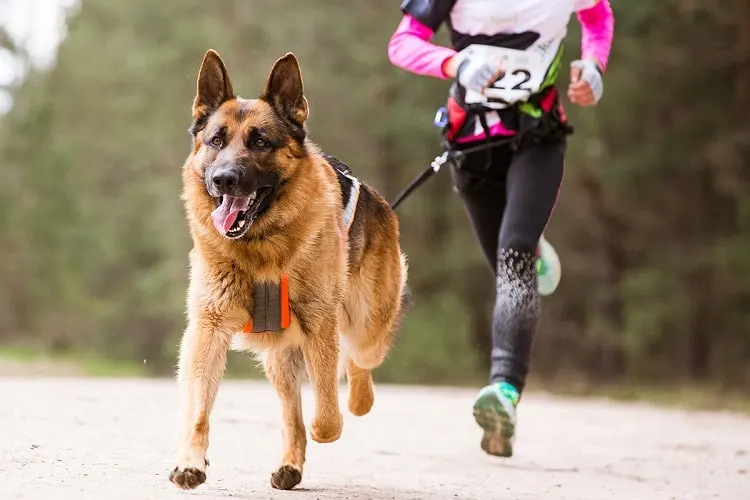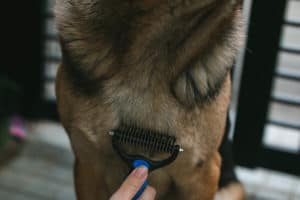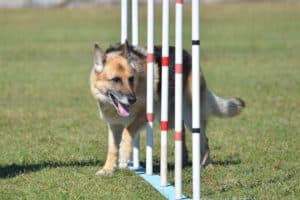German Shepherd Ear Position Meaning: Should Their Ears Stand Up?
Large, triangular ears are one of German Shepherd’s most recognizable features.
The default ear position for German Shepherds is to stand upright. However, it’s not always the case.
- Your puppy’s ears may stand at some moments and be floppy at others. It’s completely normal. Their ears will fully develop after 4–5 months.
- Floppy ears are undesirable in adult dogs. They indicate the pinna, or cartilage, in the ear hasn’t developed or appropriately hardened.
As dogs primarily communicate through body language, the position of your dog’s ears can also tell you a lot about what they’re thinking and feeling.
Unless your German Shepherd’s ears are naturally floppy, putting their ears down might be a sign of fear or anxiety.
Join us as we explore the subject in more detail below.
Should I Worry My German Shepherd’s Ears Never Stand Up Naturally?

If you talk to breeders or vets, they’ll confirm that floppy ears are a common trait in teething German Shepherd pups.
The teething phase typically concludes between the 16th and 20th week. At this stage, an essential anatomical change occurs — the cartilage in the pup’s ear undergoes a strengthening process. It plays a crucial role in helping the ear achieve its permanent upright position.
So, while floppy ears are adorable, your puppy will most likely grow out of them.
If 20 weeks pass by and your dog still doesn’t have upright ears, their ears won’t become erect naturally.
This variance in ear shapes may seem unusual, but it isn’t necessarily a cause for concern.
The shape of a dog’s ears is related to its genetic makeup, just like other physical attributes. Coat length, eye color, and coat color are all influenced by genetics. And the ear shape is no different.
So, if your German Shepherd has always had floppy ears, it could simply be down to their unique genetic blueprint. It’s rare, but it’s certainly possible.
Why My German Shepherd Suddenly Has Floppy Ears?
If your dog’s ears flopped suddenly, it might be a sign of some underlying issues. Let’s discuss the most common reasons for it below.
Poor Nutrition
German Shepherd pups require proper nutrition during their growth stages. It’s during these periods when vital body parts, including ears, are developing at an accelerated pace.
Essential vitamins and minerals play a vital role in this process.
For example, vitamin D and calcium are indispensable to the formation of the consistently hard cartilage in the ear. Deficiency in either of these nutrients can impact the normal growth process.
Simply put, these nutrients give your pet the best shot at healthy, upright ears.
Poor or improper nutrition won’t equip your pet with the necessary building blocks for growth. This deprivation can directly impact their physical development, hindering features like their iconic ears from reaching their full potential.
Poor Hygiene
Your German Shepherd’s floppy ears could also be the result of a lack of proper hygiene. Ears that are not regularly cleaned may accumulate wax, debris, or dirt. It makes them heavier, which is why they might start to droop.
If not addressed, this issue can escalate over time.
When a German Shepherd is still growing as a puppy, the structures within their ears — like bones and muscles — can also be affected by this weight. It may disrupt their natural development and cause the ears to flop over permanently.
Trauma
Puppies are known for their energy and playful nature. Given their innate curiosity and zest for life, they often get involved in all sorts of mischief.
Unfortunately, it can also expose them to a variety of risks, including the potential damage to their ears. Their delicate cartilage or muscles might sustain injuries during their lively explorations.
It could happen if they collide with objects or other animals.
Once damaged, a puppy’s ears may suffer long-term consequences. For instance, they might not stand erect as they naturally would.
This form of injury can undermine the puppy’s unique charm and indicate deeper health issues. Therefore, it’s crucial for pup owners to supervise their furry friends’ activities to ensure their safety.
Infection
An ear infection is a common issue that can occur in both the inner and outer ear. It can be either bacterial or fungal in nature.
Often, these infections are contracted after coming into contact with water. An infected ear may present itself with a noticeable droop due to inflammation caused by the ailment.
Signs to look out for when suspecting an ear infection include:
- redness and swelling of the infected area
- shaking the head
- excessive scratching at the ear
- discharge from the ear
It’s crucial to seek professional help at the first sign of infection. Veterinarians will treat this condition using either antibacterial or antifungal medications.
Swift treatment is required to avoid the infection spreading or dealing permanent damage to the ear.
How to Make a German Shepherd’s Ears Stand Up?

If your German Shepherd’s ears haven’t perked up by the fifth month, you might start to worry.
Don’t panic just yet. Having floppy ears on your German Shepherd is not a problem to fix unless it impacts their happiness or health.
That said, if you want those ears to stand up straight, there are methods to do so.
One choice some owners make is to have their dog’s ears surgically cropped or implanted. This surgical intervention aims to make the ears stand erect. Yet, this procedure has sparked a great deal of controversy.
While it remains legal in the USA, it’s not generally recommended unless necessary for health reasons. The procedure can cause undue stress and pain for dogs.
Another method to straighten your German Shepherd’s ears is by using taping. This technique involves placing tape or another supportive material inside the ear. Once set in place, the material helps to prop the ear upright and facilitates growth in that position.
The taping is usually most effective during puppyhood and takes around 3-4 weeks to show results.
Despite the promise of effectiveness, the desired outcome isn’t always guaranteed. Additionally, the taping process could create a stressful environment for dogs prone to anxiety.
Be aware that by the time your pup reaches their eighth month, their ears will solidify into their adult form. This is when they’ll usually adopt the posture they’ll retain for life.
If your dog’s ears are still floppy after seven months, consider reaching out to your vet or breeder for advice. It’s always better to seek professional guidance when it comes to your furry friend’s health and well-being.
Do Ear Positions Have Meanings
Yes, they do! Ear movements and positions have their own meaning and act as subtle cues, indicating a few different things.
Unlike humans, dogs have voluntary muscles in the ears and can move them around as needed.
Below are some common GSD ear positions that you should know and how they are related to your dog’s emotions.
Ears Down
Unless your German Shepherd dog has naturally floppy ears, keeping their ears down is likely a sign of fear or anxiety.
When a German Shepherd’s ears are down, it looks like their ears are flattened and pinned to the sides of the head. In this case, the GSD may be afraid of something in their surroundings, like a strange person or animal.
Other things to watch for in your German Shepherd’s body language that could indicate something is not right include:
- Cowering
- Hunching over
- Being stiff and rigid
- Whimpering, crying, or moaning
Upright and Relaxed
This is a good sign and indicates a happy dog.
As we’ve mentioned above, standing ears are the default ear position. It indicates a calm dog in a good mood.
Relaxed ears mean they are comfortable in their environment.
Ears Back
If the dog feels relaxed and has a wagging tail, this ear position can indicate friendly interest. It’s usually more of a “half-back” position.
Nonetheless, ears back can also be a sign of a very uncomfortable dog. Submissive dogs will also flatten their ears a lot.
Pricked or Forward
Ears forward in dogs mean something is catching their attention. This is usually just curiosity.
This ear position can also indicate unease and can escalate to aggression quickly. Use other body clues to help you determine their mood.
Flip-Flopped
Ears pointing in different directions (floppy ears) look adorable but also tell you something about your pup’s mood.
It usually means they have two focal points of interest, such as keeping an ear on you while tracking something moving behind them.
It’s generally harmless. Still, be aware that it can lead to surprise actions that you might need to control.
Flicking
This ear position means that your dog is feeling unsettled. A lot is going on in their head, and again, you need to pay attention and manage the situation as an owner.
Rapid changes in ear position could also mean they might be feeling overwhelmed. Perhaps a lot of noise or stimulus is worrying them.
Dogs can also flick their ears if flies or bugs are bothering them or if there are other dogs nearby.
Why Do Dogs Put Their Ears Down?
This is a bit of an ambiguous description and can refer to two types of ear movement in German Shepherds.
We’ve spoken a little about how some dogs don’t develop the ear ligaments and cartilage they need for the correct ear position. It leads to naturally “floppy” ears — something the breed shouldn’t have.
If you have a dog with floppy ears, and it can’t be corrected, you might see the weak ear lying down in all sorts of situations.
However, when you see a German Shepherd’s ears flat down against its head, it’s a cause for concern. Your dog needs immediate reassurance, or problems could follow.
While it’s slightly less problematic in naturally fearful or submissive dogs, it should still be addressed. After all, your dog is telling you about their discomfort.
And if your dog is confident or leans toward aggression, act immediately. Reassure the dog, diffuse the situation, and take control.
How to Calm an Anxious Dog?
As a good owner, you need to pay attention to your dog’s body language. Ear movement is likely to be one of the first signs you get.
- If you’re walking off-leash and see your GSD’s ears move to an attentive or fearful position, clip on that leash and take control!
- If your dog gives clear alarm signals, it may warn you of a danger ahead.
In the second scenario, before you try to calm your dog down or break their attention, assess if there’s a real threat or if they’re just having a little moment.
You may need to break their intense focus. This is one time when treats aren’t helpful, as it incentivizes a potentially problematic issue.
Instead, distract your dog. For instance, you can turn and walk the other way a few paces or start a new activity.
If their ears go back to “friendly mode,” you can reward good behavior.

Remember to teach your German Shepherd how to interact positively with other people and dogs.
- If you see tight, pinned, and fearful ears, it’s time to act. Sooth the dog with a calm, controlled voice.
- If your dog is naturally aggressive, address this over time through positive reinforcement and dog training.
- You should work with positive confidence-building techniques to give a naturally submissive dog more confidence in stressful situations.
While it might sound useful to have a “submissive” large breed dog, it isn’t really.
A confident and friendly dog feels secure. A submissive and fearful one is scared and can act unpredictably.
Final Thoughts
It’s totally normal if your German Shepherd has its ears down.
Nonetheless, pinned and flat ears are certainly a cause for concern. Should this happen, a responsive and responsible pet owner must immediately act.
In the long term, you should work on any fear or aggression in your dog and help them channel it in healthier ways.
Yet, in the heat of the moment, you must take control and manage your dog’s behavior so no one gets hurt.
A German Shepherd’s ears give you many clues about their state of mind, so knowing how to “read” them is certainly beneficial.
Frequently Asked Questions
How can I get my German Shepherd’s ears to stand?
There are various methods to help a German Shepherd’s ears stand, such as ear taping or using ear implants.
Why do German Shepherd puppies have floppy ears?
German Shepherd puppies have floppy ears because the muscles in their ears are not yet fully developed at a young age.
Is it normal for a German Shepherd to have one ear that doesn’t stand?
Yes, it is normal for some German Shepherds to have one ear that doesn’t stand while the other ear does.
Do German Shepherds need ear cleaning?
German Shepherds do require regular ear cleaning to prevent any build-up of dirt or wax in the ear canal.
Can German Shepherd ears stand up on their own?
Yes, some German Shepherds’ ears will naturally stand up without any assistance.




















